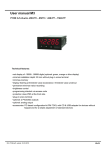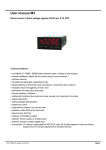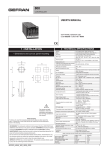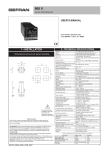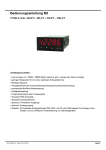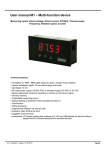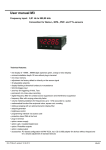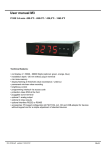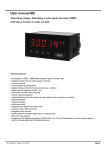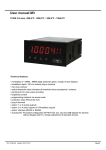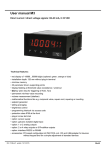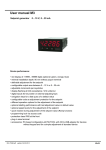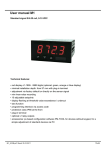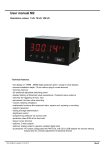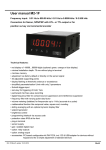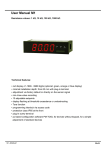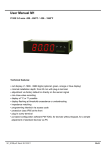Download User manual M3
Transcript
User manual M3 Thermocouple Type K, B, S, N, E, T, R, L, J Technical features: • red display from -19999…99999 Digits (optional green, orange or blue display) • minimal installation depth: 90 mm without plug-in terminal • adjustment via factory default or directly on the sensor signal • min-/max-value recording • display flashing at threshold exceedance / undercut • HOLD function • permanent MIN/MAX value recording • volume measuring (totaliser) • mathematical functions like reciprocal value, square root, square, rounding • programming interlock via access code • protection class IP65 at the front • plug-in screw terminal • optional: 2 PhotoMos outputs • optional: sensor supply or analog output • optional: digital output • accessories: pc-based configuration kit PM-TOOL incl. CD & USB adapter for devices without keypad, for a simple adjustment of standard devices M3_7TGB.pdf updated: 21.11.2011 48x24 Identification STANDARD-TYPES Thermocouple Housing size: 48x24 mm ORDER NUMBER ORDER NUMBER M3-7TR5A.040X.S70AD M3-7TR5A.040X.770AD M3-7TR5A.040X.S70AD M3-7TR5A.040X.770AD Options – breakdown of order code: M 3- 7 T R 5 B. 0 4 0 X. 7 7 2 A D Standard type M line Dimension D physical unit Installation depth 109 mm, incl. plug-in terminal 3 Version A A Housing size 48x24x90 mm (BxHxD) 7 Setpoints 0 no setpoints Display type Temperature T 2 2 PhotoMos-outputs Protection class 1 without keypad, Display colour Blue Green B G Red R Orange Y Number of digits 5-digit 5 operation on the back side 7 IP65 / plug-in terminal Supply voltage 7 24 VDC galv. insulated S 85-265 VAC Measuring input X Type K, B, S, N, E, T, R, L, J Digit height 10 mm A Analog output 0 without Digital input without 0 1 digital input I X 0-10 VDC, 0/4-20 mA Temperature devices 4 Thermocouple Please state physical unit by order. Contents 1. Assembly 2 2. Electrical connection 3 3. Function and operation description 4 4. Setting up the device 6 4.1. Switching on 6 4.2. Standard parameterisation (flat operation level) 6 4.3. Extended parameterisation (professional operation level) 10 4.3.1. Signal input parameters „INP“ 10 4.3.2. General device parameters „FCT“ 12 4.3.3. Safety parameters „COD“ 14 4.3.4. Analog output parameters „Out“ 15 4.3.5. Relay functions „rel“ 17 4.3.6. Alarm parameters „AL1…AL4“ 19 4.3.7. Programming interlock „run“ 21 4.4. Reset to default values 21 4.5. Alarms / Relay 22 5. Technical data 23 6. Safety advices 25 7. Error elimination 26 1 1. Assembly 1. Assembly Please read the Safety advices on page 25 before installation and keep this user manual for future reference. 3,0 24,0 Se alin g l ina erm t m m) m -in m 09 plug 09 m 101 m 1 . o 1 e 1 t ncl s 10 pth i evice l rang e d a d d n ion ar tio llat stand func a t Ins for nded e ext th i w ( 48 ,0 Gap for physical unit 1. 2. 3. After removing the fixing elements, insert the device. Check the seal to make sure it fits securely. Click the fixing elements back into place and tighten the clamping screws by hand. Then use a screwdriver to tighten them another half a turn. CAUTION! The torque should not exceed 0.1 Nm! Change signs of the physical unit before assembly via a channel at the side of the front! The change can only be done from the outside before assembly! 2 2. Electrical connection 2. Electrical connection 3 3. Function and operation description 3. Function and operation description Operation The operation is divided into three different levels. Menu level (delivery status) This level is for the standard settings of the device. Only menu items which are sufficent to set the device into operation are displayed. To get into the professional level, run through the menu level and parameterise “prof“ under menu item RUN. Menu group level (complete function volume) Suited for complex applications as e.g. linkage of alarms, setpoint treatment, totaliser function etc. In this level function groups which allow an extended parameterisation of the standard settings are availabe. To leave the menu group level, run through this level and parameterise „uloc„ under menu item RUN. Parameterisation level: Parameter deposited in the menu item can here be parameterised. Functions, that can be changed or adjusted, are always signalised by a flashing of the display. Settings that are made in the parameterisation level are confirmed with [P] and thus safed. By pressing the [O]-key („zero-key“) it leads to a break-off of the value input and to a change into the menu level. All adjustments are safed automatically by the device and it changes into operating mode, if no further key operation is done within the next 10 seconds. Level Key Description Change to parameterisation level and deposited values. Menu level Keys for up and down navigation in the menu level. Change into operation mode by pushing both navigation keys at the same time. To confirm the changes made at the parameterization level. Parameterisation level Adjustment of the value / the setting. Change into menu level or stop of the value input, by pushing both navigation keys at the same time. Change to menu level Menu group level Keys for up and down navigation in the menu group level. Change into operation mode or return into menu level, by pushing both navigation keys at the same time. 4 3. Function and operation description Programming via configuration software PM-TOOL-MUSB4 You receive the software on CD incl. an USB-cable with a device adaptor. The connection is done via a 4-pole micromatch connector plug on the back and the PC is connected via an USB connector plug. System requirements: PC with USB interface Software: Windows XP, Windows Vista Function chart: 5 4. Setting up the device 4. Setting up the device 4.1. Switching on Once the installation is complete, you can start the device by applying the voltage supply. Before, check once again that all electrical connections are correct. Starting sequence For 1 second during the switching-on process, the segment test (8 8 8 8 8) is displayed followed by an indication of the software type and, after that, also for 1 second the software version. After the starting sequence, the device switches to operation/display mode. 4.2. Standard parameterisation: (Flat operation level) To parameterise the display, press the [P] key in operating mode for 1 second. The display then changes to the menu level with the first menu item TYPE. Menu level Parameterisation level Selection of the input signal, tYPE: Default: typ.l Available are 9 types of thermocouple as input options (L, J, K, B, S, N, E, T, R). Confirm the selection with [P] and the display switches back to menu level. Type of temperature metering, UNIT: Default: °c The temperature can be displayed in °C or in °F. Confirm the selection with [P] and the display switches back to menu level. Setting the decimal point, DOt: Default: 0.0 The decimal point on the display and the physical unit can be changed with [▲] [▼]. If e.g. temperature measurement in °C is selected, then you can choose between 0°C and 0.0°C in the parameterisation level. Confirm with [P], the display then switches back to the menu level again. Setting the measuring range start/offset value, offs: Default: 0.0 Enter the start/offset value from the smallest to the highest digit [▲] [▼] and confirm each digit with [P]. After the last digit the display switches back to the menu level. If Sens was selected as the input option, you can only select between noca and cal. With noca, only the previously set display value is taken over, and with cal, the device takes over both the display value and the analogue input value. 6 4. Setting up the device Menu level Parameterisation level Setting the display time, SEC: Default: 1.0 then The display time is set with [▲] [▼]. The display moves up in increments of 0.1 up to 1 second and in increments of 1.0 to 10.0 seconds. Confirm the selection by pressing the [P] button. The display then switches back to the menu level again. Selection of analog output, Out.rA: Default: 4-20 Three output signals are available: 0-10 VDC, 0-20 mA and 4-20 mA, with this function, the demanded signal is selected. Setting up the final value of the analog output, Out.En: Default: 850.00 The final value is adjusted from the smallest digit to the highest digit with [▲] [▼] and digit by digit confirmed with [P]. A minus sign can only be parameterised on the highest digit. After the last digit, the device changes back into menu level. Setting up the initial value of the analog output, Out.OF: Default: -200.0 The initial value is adjusted from the smallest digit to the highest digit with [▲] [▼] and digit by digit confirmed with [P]. A minus sign can only be parameterised on the highest digit. After the last digit, the device changes back into menu level. Threshold values / Limits, LI-1: Default: 200.0 This value defines the threshold, that activates/deactivates an alarm. Hysteresis for limit values, HY-1: Default: 0.0 The delayed reaction of the alarm is the difference to the threshold value, which is defined by the hysteresis. 7 4. Setting up the device Menu level Parameterisation level Function for threshold value undercut /exceedance, Fu-1: Default: high A limit value undercut is selected with Louu (for LOW = lower limit value), a limit value exceedance with High (for HIGH = higher limit value). If e.g. limit value 1 is on a threshold level of 100 and allocated with function High, an alarm is activated by reaching of the threshold level. If the threshold value was allocated to Low, an alarm will be activated by undercutting the threshold value, as long as the hysteresis is zero. Threshold values /Limits, LI-2: Default: 300.0 This value defines the threshold, that activates/deactivates an alarm. Hysteresis for threshold values, HY-2: Default: 0.0 The delayed reaction of the alarm is the difference to the threshold value, which is defined by the hysteresis. Function if display falls below / exceeds limit value, FU-2: Default: high To indicate if the value falls below the lower limit value, Louu can be selected (LOW = lower limit value) and if it goes above the upper limit value, high can be selected (HIGH = upper limit value). LOW corresponds to the quiescent current principle and HIGH to the operating current principle. User code (4-digit number-combination, free available), U.CodE: Default: 0000 If this code was set (>0000), all parameters are locked for the user, if LOC has been selected before under menu item run. By pressing [P] for 3 seconds in operation mode, the display shows COde. The U.Code needs to be entered to get to the reduced number of parameter sets. The code has to be entered befor each parameterisation, until the A.Code (Master code) unlocks all parameters again. 8 4. Setting up the device Menu level Parameterisation level Master code (4-digit number-combination, free available), A.CodE: Default: 1234 All parameters can be unlocked with this code, after LOC has been activated under menu item run. By pressing [P] for 3 seconds in operation mode, the display shows COde and enables the user to reach all parametes by entering the A.codE. Under run the parametrisation can be activated permanently by selecting ULOC or ProF, thus at an anew pushing of [P] in operation mode, the code needs not to be entered again. Activation / deactivation of the programming lock or completion of the standard parameterization with change into menu group level (complete function range), run: Default: uloc With the navigation keys [▲] [▼], you can choose between the deactivated key lock Uloc (works setting) and the activated key lock Loc, or the change into the menu group level ProF. Confirm the selection with [P]. After this, the display confirms the settings with "- - - - -", and automatically switches to operating mode. If Loc was selected, the keyboard is locked. To get back into the menu level, press [P] for 3 seconds in operating mode. Now enter the CODE (works setting 1 2 3 4) that appears using [▲] [▼] plus [P] to unlock the keyboard. FAIL appears if the input is wrong. To parameterize further functions ProF needs to be set. The device confirms this setting with „- - - - - „ and changes automatically in operation mode. By pressing [P] for approx. 3 seconds in operation mode, the first menu group InP is shown in the display and thus confirms the change into the extended parameterisation. It stays activated as long as ULOC or LOC is entered in menu group RUN. 9 4. Setting up the device 4.3. Extended parametersation (Professional operation level) 4.3.1. Signal input parameters Menu group level Menu level Menu level Parameterisation level Selection of the input signal, tYPE: Default: typ.l Available are 9 types of thermocouple as input options (L, J, K, B, S, N, E, T, R). Confirm the selection with [P] and the display switches back to menu level. Type of temperature metering UNIT: Default: °C The temperature can be displayed in °C or in °F. Confirm the selection with [P] and the display switches back to menu level. Setting the decimal point, DOt: Default: 0.0 The decimal point on the display and the physical unit can be changed with [▲] [▼]. If e.g. temperature measurement in °C is selected, then you can choose between 0°C and 0.0°C in the parameterisation level. Confirm with [P], the display then switches back to the menu level again. Setting the measuring range start/offset value, offs: Default: 0.0 Enter the start/offset value from the smallest to the highest digit [▲] [▼] and confirm each digit with [P]. After the last digit the display switches back to the menu level. If Sens was selected as the input option, you can only select between noca and cal. With noca, only the previously set display value is taken over, and with cal, the device takes over both the display value and the analogue input value. 10 4. Setting up the device Menu level Parameterisation level Setting the display time, SEC: Default: 1.0 then The display time is set with [▲] [▼]. The display moves up in increments of 0.1 up to 1 second and in increments of 1.0 to 10.0 seconds. Confirm the selection by pressing the [P] button. The display then switches back to the menu level again. Display underflow, dI.Und: Default: -i9999 With this function the device undercut (_ _ _ _ _) can be defined on a definite value. Display overflow, dI.OUE: Default: 99999 _____ With this function the display overflow ( ) can be defined on a definite value. Back to menu group level, rEt: With [P] the selection is confirmed and the device changes into menu group level „–INP-“. 11 4. Setting up the device 4.3.2. General device parameters Menu group level Menu level Menu level Parameterisation level Display time, DISEC: Default: 01.0 then The display is set up with [▲] [▼]. Thereby it switches until 1 second in increments of 0.1 seconds and until 10.0 seconds in increments of 1.0. With [P] the selection is confirmed and the device changes into menu level. Rounding of display values, round: Default: 00001 This function is for instable display values, where the display value is changed in increments of 1-, 5-, 10- or 50. This does not affect the resolution of the optional outputs. With [P] the selection is confirmed and the device changes into menu level. Display, dISPL: Default: actua With this function the current measurand, Min-/Max value or the process-controlled Hold-value can be allocated to the display. With [P] the selection is confirmed and the device changes into menu level. Display flashing, FLASH: Default: no A display flashing can be added as additional alarm function either to single or to a combination of off-limit condition. With no, no flashing is allocated. 12 4. Setting up the device Menu level Parameterisation level Assignment (deposit) of key functions, tASt: Default: no For the operation mode, special functions can be deposited on the navigation keys [▲] [▼], in particular this function is made for devices in housing size 48x24 which do not have a 4th key ([O]-key). If the MIN-/MAX-memory is activated with EHtr, all measured MIN/MAX-values are safed during operation and can be recalled via the navigation keys. The values get lost by re-start of the device. If the threshold value correction LI.12 or LI.34 is choosen, the values of the threshold can be changed during operation without disturbing the operating procedure. If no is selected, the navigation keys are without function in the operation mode. Special function digital input, dIG.In: Default: no … For operating mode, special functions can be realised via the digital input. This function is actuted by a voltage signal on the terminal of the digital input. With tArA the device is tared to zero and safed permanently as offset. The display acknowledges this with ooooo in the display. Set.tA switches into the offset value and can be changed via the navigation keys. Via totAL the current value of the totaliser can be displayed for approx. 7 seconds, after this the device switches back on the parametrised display value. If tot.rE is deposited, the totaliser can be set back by switching on the digital input the device acknowledges this with ooooo in the display. EHt.rE deletes the MIN/MAX-memory. If HOLD has been selected, the moment can be hold constant by pressing the [O]-key, and is updated by releasing the key. Advice: Hold is activated only, if HOLD is selected under parameter DISPL. ActuA shows the measuring value for approx. 7 seconds, after this the device switches back on the parametrised display value. At AL-1…AL-4 there can be set an output and therewith e.g. a setpoint adjustment can be done. If no is selected, the [O]-key is without any function in the operation mode. Back to menu group level, rEt: With [P] the selection is confirmed and the device changes into menu group level „– fct –“. 13 4. Setting up the device 4.3.3. Safety parameters Menu group level Menu level Menu level Parameterisation level User code U.Code: Default: 0000 Via this code, reduced sets of parameters can be set free. A change of the U.CodE can be done via the correct input of the A.CodE (master code). Master code, A.Code: Default: 1234 By entering A.CodE the device will be unlocked and all parameters are released. Release/lock analog output parameter, Out.LE: Default: all Analog output parameters can be locked or released for the user: - At En-oF the initial or final value can be changed in operation mode. - At Out.EO the output signal can be changed from e.g. 0-20mA to 4-20mA or 0-10VDC. - At ALL analog output parameters are released. - At no all analog output parameters are locked. Release/lock alarm parameters, AL.LEU: Default: all This parameter describes the user relase/user lock of the alarm. - LIMIt, here only the range of value of the threshold values 1-4 can be changed. - ALrM.L, here the range of value and the alarm trigger can be changed. - ALL, all alarm parameters are released. - no, all alarm parameters are locked. 14 4. Setting up the device Menu level Parameterisation level Back to menu group level, rEt: With [P] the selection is confirmed and the device changes into menu group level „– COD –“. 4.3.4. Analog output parameters for analog output Menu group level Menu level Menu level Parameterisation level Selection reference of analog output, OutPt: Default: actua The analog output signal can refer to different functions, in detail this are the current measuring value, min-value or max-value. If HoLd is selected the signal of the analog output will be hold and processed just after deactivation of HOLD. With [P] the selection is confirmed and the device changes into menu level. Selection analog output, Out.rA: Default: 4-20 There are 3 output signals availabe: 0-10 VDC, 0-20 mA and 4-20 mA. With this function the demanded signal can be selected. Setting up the final value of the analog output, Out.En: Default: 10000 The final value can be adjusted from the smallest to the highest digit with [▲] [▼]. Confirm each digit with [P]. A minus sign can only be parameterized on the highest value digit. After the last digit, the display switches back to the menu level. 15 4. Setting up the device Menu level Parameterisation level Setting up the initial value of the analog output, Out.OF: Default: 00000 The initial value can be adjusted from the smallest to the highest digit with [▲] [▼]. Confirm each digit with [P]. A minus sign can only be parameterized on the highest value digit. After the last digit, the display switches back to the menu level. Overflow behaviour, O.FLoU: Default: edge To recognise and evaluate faulty signals, e.g. by a controller, the overflow behaviour of the analog output can be defined. As overflow can be seen either EdGE, that means the analog output runs on the set limits e.g. 4 and 20 mA, or to.OFF (input value smaller than initial value, analog output switches on e.g. 4 mA), to.End (higher than final value, analog output switches on e.g. 20 mA). If to.MIn or to.MAX is set, the analog output switches on the smallest or highest possible binary value. This means that values of e.g. 0 mA, 0 VDC or values higher than 20 mA or 10 VDC can be reached. With [P] the selection is confirmed and the device changes into menu level. Back to menu group level, rEt: With [P] the selection is confirmed and the device changes into menu group level „– out –“. 16 4. Setting up the device 4.3.5. Relay functions Menu group level Menu level Menu level Parameterisation level Alarm relay 1, rEL-1: Default: al-1 …. …. Each setpoint (optional) can be linked up via 4 alarms (by default). This can either be inserted at activated alarms Al-1/4 or de-activated alarms Aln1/4. If LOGIC is selected, logical links are available in the menu level Log-1 and Com-1. One can only get to these two menu levels via LOGic, at all other selected functions, these two parameters are overleaped. Via On/OFF the setpoints can be activated/de-activated, in this case the output and the setpoint display are set/not set on the front of the device. With [P] the selection is confirmed and the device changes into menu level. Logic relay 1, Log-1 Default: or Here, the switching behaviour of the relay is defined via a logic link, the following schema describes these functions with inclusion of AL-1 and AL-2: A1 v A2 ____ _ _ As soon as a selected alarm is activated, the relay operates. Equates to operating current principle. A1 v A2 = A1 Λ A2 The relay operates only, if no selected alarm is active. Equates to quiescent current principle. A1 Λ a2 The relay operates only, if all selected alarms are active. ____ _ _ A1 Λ A2 = A1 v A2 As soon as a selected alarm is not activated, the relay operates. With [P] the selection is confirmed and the device changes into menu level. 17 4. Setting up the device Menu level Parameterisation level Alarms for relay 1, CoM-1: Default: a.i …. The allocation of the alarms to relay 1 happens via this parameter, one alarm or a group of alarms can be chosen. With [P] the selection is confirmed and the device changes into menu level. Alarm relay 2, rEL-2: Default: al-2 …. …. Each setpoint (optional) can be linked up via 4 alarms (by default). This can either be inserted at activated alarms Al-1/4 or de-activated alarms Aln1/4. If LOGIC is selected, logical links are available in the menu level Log-1 and Com-1. One can only get to these two menu levels via LOGic, at all other selected functions, these two parameters are overleaped. Via On/OFF the setpoints can be activated/de-activated, in this case the output and the setpoint display are set/not set on the front of the device. With [P] the selection is confirmed and the device changes into menu level. Logic relay 2, Log-2: Default: or Here, the switching behaviour of the relay is defined via a logic link, the following schema describes these functions with inclusion of AL-1 and AL-2: A1 v A2 ____ _ _ As soon as a selected alarm is activated, the relay operates. Equates to operating current principle. A1 v A2 = A1 Λ A2 The relay operates only, if no selected alarm is active. Equates to quiescent current principle. A1 Λ a2 The relay operates only, if all selected alarms are active. ____ _ _ A1 Λ A2 = A1 v A2 As soon as a selected alarm is not activated, the relay operates. With [P] the selection is confirmed and the device changes into menu level. 18 4. Setting up the device Menu level Parameterisation level Alarms for relay 2, CoM-2: Default: a.2 …. The allocation of the alarms to relay 5 happens via this parameter, one alarm or a group of alarms can be chosen. With [P] the selection is confirmed and the device changes into menu level. Back to menu group level, rEt: With [P] the selection is confirmed and the device changes into menu group level „– rel –“. 4.3.6. Alarm parameters Menu group level Menu level Menu level Parameterisation level Dependency alarm1, ALrM.1: Default: actua The dependency of alarm 1 can be related to special functions, in detail these are the current measurand, the MIN-value or the MAX-value. If Hold is selected, then the alarm is hold and processed just after deactivation of HOLD. EHtEr causes the dependency by an external signal via the digital input. With [P] the selection is confirmed and the device changes into menu level. Threshold values / Limit values, LI-1: Default: 200.0 The limit value defines the threshold, that activates/deactivates an alarm. 19 4. Setting up the device Menu level Parameterisation level Hysteresis for threshold values, HY-1: Default: 0.0 The delayed reaction of the alarm is the difference to the threshold value, which is defined by the hysteresis. Function for threshold value undercut /exceedance, Fu-1: Default: high A limit value undercut is selected with Louu (for LOW = lower limit value), a limit value exceedance with High (for HIGH = higher limit value). If e.g. limit value 1 is on a threshold level of 100 and allocated with function High, an alarm is activated by reaching of the threshold level. If the threshold value was allocated to Low, an alarm will be activated by undercutting the threshold value, as long as the hysteresis is zero. Switching-on delay, ton-1: Default: 000 For limit value 1 one can preset a delayed switching-on of 0-100 seconds. Switching-off delay, toF-1: Default: 000 For limit value 1 one can preset a delayed switching-off of 0-100 seconds. Back to menu group level, rEt: With [P] the selection is confirmed and the device changes into menu group level „– Al1 –“. The same applies for –Al2– to –Al8–. 20 4. Setting up the device 4.3.7. Programming interlock, run: Menu group level Description see page 11, menu level run 4.4. Reset to default values To return the unit to a defined basic state, a reset can be carried out to the default values. The following procedure should be used: • Switch off the power supply • Press button [P] • Switch on voltage supply and press [P]-button until „- - - - -“ is shown in the display. With reset, the default values of the program table are loaded and used for subsequent operation. This puts the unit back to the state in which it was supplied. Caution! All application-related data are lost. 21 4. Setting up the device 4.5. Alarms / Relays This device has 4 virtual alarms that can monitor one limit value in regard of an undercut or exceedance. Each alarm can be allocated to an optional relay output S1-S2; furthermore alarms can be controlled by events like e.g. Hold or Min-/Max-value. Function principle of alarms / relays Alarm / Relay x Deactivated, instantaneous value, Min-/Max-value, Hold-value Switching threshold Threshold / limit value of the change-over Hysteresis Broadness of the window between the switching thresholds Working principle Operating current / Quiescent current Operating current By operating current the alarm S1-S2 is off below the threshold and on on reaching the threshold. Quiescent current By quiescent current the alarm S1-S2 is on below the threshold and switched off on reaching the threshold. Switching-on delay The switching-on delay is activated via an alarm and e.g. switched 10 seconds after reaching the switching threshold, a short-term exceedance of the switching value does not cause an alarm, respectively does not cause a switching operation of the relay. The switching-off delay operates in the same way, keeps the alarm / the relay switched longer for the parametrised time. 22 5. Technical data 5. Technical data Housing Dimensions 48x24x90 mm (BxHxD) 48x24x109 mm (BxHxD) incl. plug-in terminal Panel cut-out 45.0+0.6 x 22.2+0.3 mm Wall thickness up to 3 mm Fixing Screw elements Material PC Polycarbonate, black, UL94V-0 Sealing material EPDM, 65 Shore, black Protection class Standard IP65 (Front side), IP00 (Back side) Weight approx. 200 g Connection Plug-in terminal; wire cross section up to 2.5 mm2 Display Digit height 10 mm Segment colour Red (optional green, yellow or blue) Range of display -19999 to 99999 Setpoints one LED per setpoint Overflow Horizontal bars at the top Underflow Horizontal bars at the bottom Display time 0.1 to 10.0 seconds Input Measuring range Measuring error Digit Type L (Fe-CuNi alter Typ) -200,0…-900,0°C 2K ±1 Type J (Fe-CuNi) -210,0…1200,0°C 2K ±1 Type K (NiCr-NiAL) -270,0…1372,0°C 2K ±1 Type B (Pt30Rh-Pt6Rh) 80,0…1820,0°C 2K ±1 Type S (Pt10Rh-Pt) -50,0…1768,0°C 2K ±1 Type N (NiCrSi-NiSi) -270,0…1300°C 2K ±1 Type E (NiCr-CuNi) -270,0…1000,0°C 2K ±1 Type T (Cu-Cu-Ni) -270,0…400,0°C 2K ±1 Type R (Pt13Rh-Pt) -50,0…1768,0°C 2K ±1 Digital input < 2,4 V OFF, 10 V ON, max. 30 VDC RI ~ 5 kΩ 23 5. Technical data Accuracy Characteristic line error < ±1 Reference junction semiconductor sensor Temperature drift 100 ppm / K Measuring time 0.1…10.0 seconds Measuring principle U/F-converter Resolution 0.1°C or 0.1°F Output Analog output 0/4-20 mA or 0-10 VDC 16 Bit switchable Switching outputs 2 PhotoMos (Closer) Power pack 85-265 VAC (max. 10 VA) 24 VDC +/- 10 % galv. insulated (max. 4 A) Memory EEPROM Data life ≥ 100 years Ambient conditions Working temperature 0…50°C Storing temperature -20…80°C Weathering resistance relative humidity 0-80% on years average without dew EMV EN 61326 CE-sign Conformity to directive 2004/108/EG Safety standard According to low voltage directive 2006/95/EG EN 61010; EN 60664-1 24 6. Safety advices 6. Safety advices Please read the following safety advices and the assembly in chapter 1 before installation and keep it for future reference. Proper use The M3-device is designed for the evaluation and display of sensor signals. Danger! Careless use or improper operation can result in personal injury and/or damage to the equipment. Control of the device The panel meters are checked before dispatch and sent out in perfect condition. Should there be any visible damage, we recommend close examination of the packaging. Please inform the supplier immediately of any damage. Installation The M3-device must be installed by a suitably qualified specialist (e.g. with a qualification in industrial electronics). Notes on installation • There must be no magnetic or electric fields in the vicinity of the device, e.g. due to transformers, mobile phones or electrostatic discharge. • The fuse rating of the supply voltage should not exceed a value of 6A N.B. fuse. • Do not install inductive consumers (relays, solenoid valves etc.) near the device and suppress any interference with the aid of RC spark extinguishing combinations or freewheeling diodes. • Keep input, output and supply lines separate from one another and do not lay them parallel with each other. Position “go” and “return lines” next to one another. Where possible use twisted pair. So, you receive best measuring results. • Screen off and twist sensor lines. Do not lay current-carrying lines in the vicinity. Connect the screening on one side on a suitable potential equaliser (normally signal ground). • The device is not suitable for installation in areas where there is a risk of explosion. • Any electrical connection deviating from the connection diagram can endanger human life and/or can destroy the equipment. • The terminal area of the device is part of the service. Here electrostatic discharge needs to be avoided. Attention! High voltages can cause dangerous body currents. • Galvanic insulated potentials within one complex need to be placed on a appropriate point (normally earth or machines ground). So, a lower disturbance sensibility against impacted energy can be reached and dangerous potentials, that can occur on long lines or due to faulty wiring, can be avoided. 25 7. Error elimination 7. Error elimination Error description Measures 1. The unit permanently indicates overflow. • The input has a very high measurement, check the measuring circuit. • With a selected input with a low voltage signal, it is only connected on one side or the input is open. • Not all of the activated setpoints are parameterised. Check if the relevant parameters are adjusted correctly. 2. The unit permanently shows underflow. • The input has a very low measurement, check the measuring circuit . • With a selected input with a low voltage signal, it is only connected on one side or the input is open. • Not all of the activated setpoints are parameterised. Check if the relevant parameters are adjusted correctly. 3. The word "HELP " lights up in the 7-segment display. • The unit has found an error in the configuration memory. Perform a reset on the default values and re-configure the unit according to your application. 4. Program numbers for parameterising of the input are not accessible. • Programming lock is activated • Enter correct code 5. "Err1" lights up in the 7-segment display • Please contact the manufacturer if errors of this kind occur. 6. The device does not react as expected. • If you are not sure if the device has been parameterised before, then follow the steps as written in chapter 5.2. and set it back to its delivery status. M3_7TGB.pdf 26 updated: 21.11.2011





























